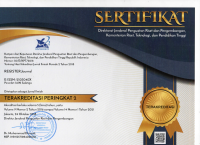THE ORAL AND WRITTEN LANGUAGE PROFICIENCY OF AN INDONESIAN BILINGUAL CHILD IN THE OHIO STATE, USA
Abstract
This study was a qualitative case study conducted to investigate the oral
and written language proficiency of an Indonesian bilingual child living in
The Ohio State, USA. There were three research questions guiding this
study as follows: (1) how the bilingual Indonesian child used the
languages she spoke in oral and written forms?, (2) how was the child’s
oral proficiency for each language she spoke?, and (3) how was the child’s
written language proficiency for each language she spoke? The data in this
study were gathered through analytical observation sheets, semi
structured interviews, audio and video recording and transcriptions, and
reading aloud and writing scoring. Then, the data were analyzed using
inductive analysis such as doing field work to observe and recording the
data, developing topics and categorizing the data into categories, refining
and coding the data into more specific patterns to see the themes of the
data, and seeking for narrative structures and visual representations.
Based on the results of the study, there were three points concluded. First,
my focal student and her community chose different languages to
communicate based on the listeners’ cultural background, age, and gender.
Second, the Indonesian parents living there had an awareness of the
importance of heritage language in spoken and written forms. Third, the
student’ oral and written language proficiency in English were higher than
in Indonesian and Javanese. In conclusion, the student needed more space
for developing her abilities in Indonesian and Javanese.
Keywords: bilingual, bilingualism, biliteracy, language proficiency
Full Text:
PDFDOI: http://dx.doi.org/10.30659/e.1.2.158-176
Refbacks
- There are currently no refbacks.
Copyright (c) 2016 EDULITE










